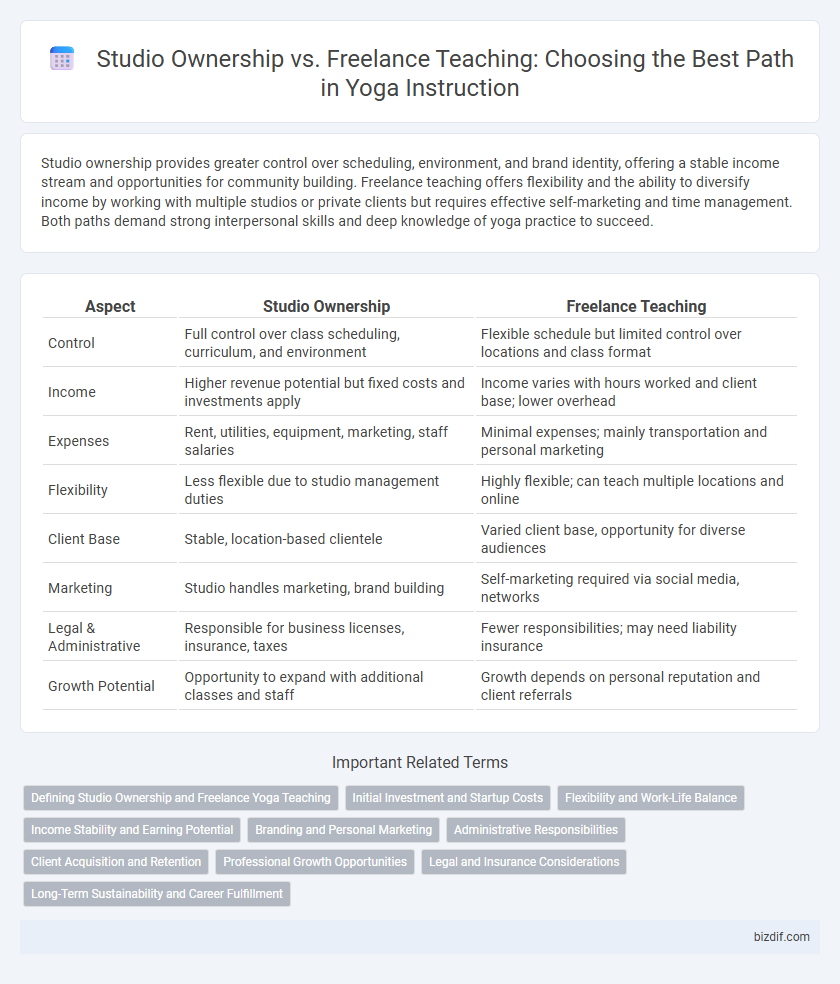Studio ownership provides greater control over scheduling, environment, and brand identity, offering a stable income stream and opportunities for community building. Freelance teaching offers flexibility and the ability to diversify income by working with multiple studios or private clients but requires effective self-marketing and time management. Both paths demand strong interpersonal skills and deep knowledge of yoga practice to succeed.
Table of Comparison
| Aspect | Studio Ownership | Freelance Teaching |
|---|---|---|
| Control | Full control over class scheduling, curriculum, and environment | Flexible schedule but limited control over locations and class format |
| Income | Higher revenue potential but fixed costs and investments apply | Income varies with hours worked and client base; lower overhead |
| Expenses | Rent, utilities, equipment, marketing, staff salaries | Minimal expenses; mainly transportation and personal marketing |
| Flexibility | Less flexible due to studio management duties | Highly flexible; can teach multiple locations and online |
| Client Base | Stable, location-based clientele | Varied client base, opportunity for diverse audiences |
| Marketing | Studio handles marketing, brand building | Self-marketing required via social media, networks |
| Legal & Administrative | Responsible for business licenses, insurance, taxes | Fewer responsibilities; may need liability insurance |
| Growth Potential | Opportunity to expand with additional classes and staff | Growth depends on personal reputation and client referrals |
Defining Studio Ownership and Freelance Yoga Teaching
Studio ownership involves managing a physical space dedicated to yoga classes, encompassing responsibilities like scheduling, marketing, and facility maintenance. Freelance yoga teaching emphasizes flexibility and autonomy, allowing instructors to conduct classes in various locations without the overhead of studio management. Both roles require expertise in yoga instruction but differ significantly in business obligations and operational control.
Initial Investment and Startup Costs
Starting a yoga studio typically requires a significant initial investment, including lease agreements, renovation, equipment purchases, and marketing expenses, often totaling tens of thousands of dollars. Freelance yoga teaching demands far lower startup costs, primarily limited to certification, insurance, and minimal props, enabling quicker entry into the market with reduced financial risk. Understanding the disparity in initial capital outlay is crucial for aspiring instructors deciding between studio ownership and freelance teaching pathways.
Flexibility and Work-Life Balance
Studio ownership offers structured schedules and consistent income but often demands administrative duties that reduce personal time, impacting work-life balance. Freelance yoga teaching allows greater flexibility in class timing and location, promoting a more adaptable lifestyle and improved work-life harmony. Balancing client acquisition and income stability remains crucial for freelancers seeking sustainable flexibility.
Income Stability and Earning Potential
Studio ownership offers consistent income through membership fees and class packages, providing greater financial stability compared to freelance teaching. Freelance instructors often experience variable earnings dependent on class availability and student volume, limiting predictable income streams. However, freelancers can increase earning potential by diversifying clients and expanding into workshops or private sessions.
Branding and Personal Marketing
Studio ownership enables comprehensive control over branding, creating a unique identity that attracts a loyal client base through consistent messaging and ambiance. Freelance teaching relies heavily on personal marketing strategies, leveraging social media presence, word-of-mouth, and niche expertise to build a strong personal brand. Both paths demand distinct approaches to visibility and client engagement, with studio owners focusing on place-based credibility and freelancers emphasizing individual authority and flexibility.
Administrative Responsibilities
Owning a yoga studio involves managing administrative responsibilities such as lease agreements, staff payroll, marketing strategies, and client management systems, which require strong organizational skills and time commitment. Freelance yoga instructors primarily handle scheduling classes, client communication, and payment processing, allowing greater flexibility but limited control over venue-related tasks. Administrative duties for studio owners are more extensive, encompassing financial reporting, compliance with health and safety regulations, and maintaining professional liability insurance.
Client Acquisition and Retention
Studio ownership provides a stable client base through built-in memberships and recurring class schedules, enhancing long-term retention and consistent revenue streams. Freelance teaching demands proactive marketing and diverse networking to continuously attract new clients, emphasizing personalized relationships and versatility in class offerings. Both models require strategic client engagement but differ in scalability and dependence on self-driven acquisition efforts.
Professional Growth Opportunities
Owning a yoga studio offers direct control over class schedules, branding, and client relationships, fostering long-term professional growth through business management skills. Freelance teaching provides diverse experiences by working in various studios and with different student demographics, enhancing adaptability and expanding professional networks. Each path shapes expertise uniquely, with studio ownership focusing on entrepreneurial development and freelancing emphasizing flexibility and broader instructional exposure.
Legal and Insurance Considerations
Studio ownership requires comprehensive liability insurance and adherence to zoning laws, which protect against accidents and legal claims within the premises. Freelance yoga instructors must secure personal professional liability insurance to cover injuries or disputes arising during sessions at various locations. Both formats necessitate thorough contracts detailing indemnity clauses to mitigate legal risks and ensure compliance with local regulations.
Long-Term Sustainability and Career Fulfillment
Owning a yoga studio offers long-term sustainability through steady client retention, brand building, and diversified income streams such as workshops and merchandise. Freelance teaching provides career fulfillment with flexible schedules, diverse teaching environments, and the opportunity to connect with a wide range of students. Balancing studio management responsibilities against the freedom of freelance work is crucial for lasting success in the yoga industry.
Studio Ownership vs Freelance Teaching Infographic

 bizdif.com
bizdif.com